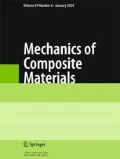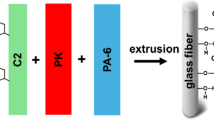For a reliable structural design of security-relevant, high-dynamically loaded light weight structures, the knowledge of the strain-rate-dependent material and damage behaviour, material properties, and validated material models have to be provided. For this purpose, various material tests at different strain rates have been performed on composites with a novel 3D-reinforced glass-fibre multilayered flat-bed weft-knitted fabric reinforcement by using a servohydraulic high-speed testing unit in combination with specially adapted clamping de vices. The highly dynamic material tests served to develop adequate material models in the classical sense of continuum damage mechanics and to determine the associated model parameters.
Similar content being viewed by others
References
W. Hufenbach, M. Gude, and Ch. Ebert, Dehnratenabhängiges Versagensverhalten von Verbundwerkstoffen mit 3D-Textilverstärkung. 15. DGM-Sym po sium “Verbundwerkstoffe und Werkstoffverbunde,” April 6–8, 2005, Kassel (auf CD-ROM).
W. Hufenbach, M. Gude, and Chr. Ebert, “Tailored 3D-textile reinforced composites with load-adapted property profiles for crash and impact applications,” Composites, 6, No. 3, 8–13 (2006).
W. Hufenbach (ed.), “Textile Verbundbauweisen und Fertigungstechnologien für Leichtbaustrukturen des Fahrzeugund Maschinenbaus,” Leitfaden des DFGS-chwerpunktprogramms, Erscheinungsdatum: Oktober (2007).
K. V. Williams and R. Vazari, “Application of a damage mechanics model for predicting the impact response of composite materials,” Comput. Struct., 79, 997–1011 (2001).
J. M. Withney and R. L. McCullough, Micromechanical Materials Modeling,. Vol. 2, Delaware Composites Design Encyclopedia, Technomic Publishing Company, Inc., Lancaster, Pennsylvania, U.S.A. (1990).
B. Song and C. Weinong, “Quasi-static and dynamic compressive behaviors of S-2 glass/SC15 composite,” Compos. Mater., 37, No. 19, 1723–1743 (2003).
M.V. Hosur, J. Alexander, U. K. Vaidya, and S. Jeelani, “High strain rate compression response of carbon/epoxy laminate composites,” Compos. Struct., 52, 405–417 (2001).
H. M. Hsiao, I. M. Daniel, and R. D. Cordes, “Strain rate effects on the transverse compressive behavior of unidirectional composites,” J. Compos. Mater., 33, No. 17, 1620–1642 (1999).
J. Harding, “Effect of strain rate and specimen geometry on the compressive strength of woven glass-reinforced epoxy laminates,” Composites, 24, No. 4, 323–332 (1993).
J. Harding and L. Dong, “Effect of strain rate on interlaminar shear strength of carbon-fiber reinforced laminates,” Compos. Sci. Technol., 53, No. 3, 347–358 (1994).
S. M. Werner and C. K. H. Dharan, “The dynamic response of graphite fiber-epoxy laminates at high shear strain rates,” J. Compos. Mater., 20, 365–374 (1986).
W. Hufenbach, N. Petrinic, M. Gude, A. Langkamp, and M. Andrich, “Experimentelle Versagensanalyse von textilverstärkten Verbundwerkstoffen bei hochdynamischer Belastung,” in: H. P. Degischer (ed.), Verbundwerkstoffe und Werkstoffverbunde, WILEY-VCH-Verlag, Weinheim (2003), pp. 423–428.
W. Hufenbach, R. Böhm, and A. Langkamp, “An anisotropic damage model for the prediction of the degradation behaviour of novel textile reinforced composites,” in: 21st Int. Congr. Theoret. Appl. Mech. (ICTAM-21), Warsaw, August 15–21 (2004), auf CD-ROM.
O. Diestel and P. Offermann, “Thermoplastische GF/PP-Verbunde aus biaxial verstärkten Mehrlagengestricken. Werkstoff zur Verbesserung der passiven Fahrzeugsicherheit?” Techn. Textilien/Techn. Textiles, 43, No. 4, 274–277 (2000).
Author information
Authors and Affiliations
Corresponding author
Additional information
Russian translation published in Mekhanika Kompozitnykh Materialov, Vol. 45, No. 5, pp. 677–688, September–October, 2009.
Rights and permissions
About this article
Cite this article
Gude, M., Hufenbach, W. & Ebert, C. The strain-rate-dependent material and failure behaviour of 2D and 3D non-crimp glass-fibre-reinforced composites. Mech Compos Mater 45, 467–476 (2009). https://doi.org/10.1007/s11029-009-9108-3
Received:
Published:
Issue Date:
DOI: https://doi.org/10.1007/s11029-009-9108-3




